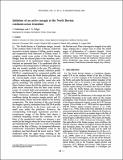Por favor, use este identificador para citar o enlazar a este item:
http://hdl.handle.net/10261/171637COMPARTIR / EXPORTAR:
 SHARE SHARE
 CORE
BASE CORE
BASE
|
|
| Visualizar otros formatos: MARC | Dublin Core | RDF | ORE | MODS | METS | DIDL | DATACITE | |

| Título: | Initiation of an active margin at the North Iberian continent-ocean transition |
Autor: | Gallastegui, J.; Pulgar, J. A.; Gallart Muset, Josep CSIC ORCID | Fecha de publicación: | 2002 | Editor: | American Geophysical Union | Citación: | Tectonics 21: 15-1-15-14 (2002) | Resumen: | The North Iberian or Cantabrian margin, located at the southern flank of the Bay of Biscay, underwent successive tectonic regimes of rifting, passive margin, and compression from Mesozoic to Tertiary times. A complete crustal cross section of the North Iberian Margin, from the abyssal plain to the shoreline, and a reconstruction of its undeformed Upper Cretaceous structure are presented here. It is constrained after the compilation and interpretation of different geophysical data sets recently available in the area. The reflective pattern is provided by deep seismic reflection profile ESCIN-4, complemented by commercial profiles and well information from the North Iberian platform, and the velocity-depth control comes from an onshore-offshore wide-angle seismic profile, tested also with gravity modeling. The detailed cross section of the Meso-Tertiary basins that fill the platform and abyssal plain shows structures from the three main tectonic events: (1) normal faults and asymmetric basins from the Permian to lower Cretaceous extensional stage; (2) Upper Cretaceous sediments deposited under stable conditions during the passive margin period; and (3) inverted faults, thrusts and folds related to the Tertiary compression. The deep structure of the crust beneath the margin is poorly constrained from ESCIN-4 profile that shows reflectivity in the lower crust only at a small area under the platform. However, the corresponding wide-angle experiment provides a conspicuous image of the Moho that shows a continued deepening toward the continent. On the basis of the geophysical results, we propose a new model for this margin where the lower crust is detached and underthrusted to the south as a result of the partial closure of the Bay of Biscay. An interpreted Mesozoic crustal-scale extensional detachment could be the weakness zone that allowed the lower crust to >slide> southward under the upper crust, resulting in the indentation of the Cantabrian Margin lower crust into the Iberian crust. Plate convergence stopped at an early stage, making this a unique area to study the initial stages of deformation of a passive margin. | URI: | http://hdl.handle.net/10261/171637 | DOI: | 10.1029/2001TC901046 | Identificadores: | doi: 10.1029/2001TC901046 issn: 0278-7407 |
| Aparece en las colecciones: | (Geo3Bcn) Artículos |
Ficheros en este ítem:
| Fichero | Descripción | Tamaño | Formato | |
|---|---|---|---|---|
| Gallart_Tectonics_21_4.pdf | 5,57 MB | Adobe PDF |  Visualizar/Abrir |
CORE Recommender
SCOPUSTM
Citations
98
checked on 08-abr-2024
WEB OF SCIENCETM
Citations
91
checked on 15-feb-2024
Page view(s)
225
checked on 18-abr-2024
Download(s)
380
checked on 18-abr-2024
Google ScholarTM
Check
Altmetric
Altmetric
NOTA: Los ítems de Digital.CSIC están protegidos por copyright, con todos los derechos reservados, a menos que se indique lo contrario.
